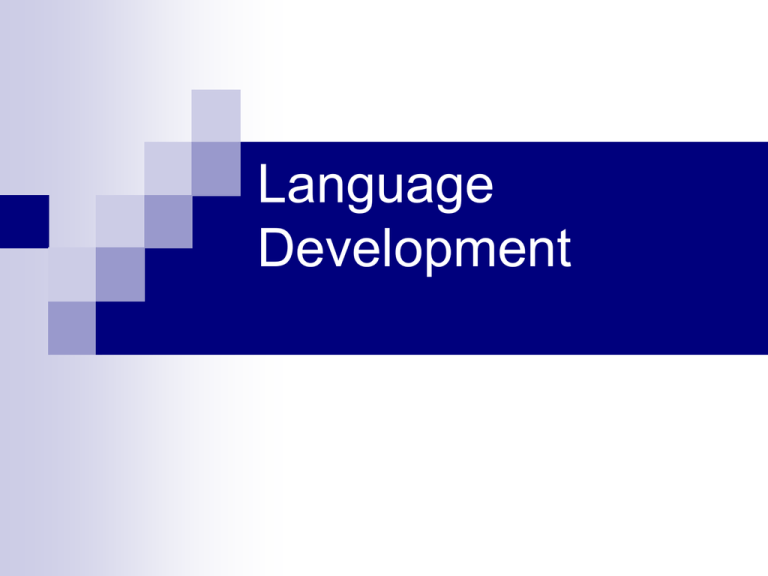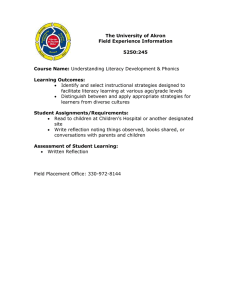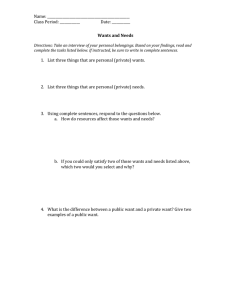Language Development
advertisement

Language Development What Is Language? Symbolic system Socially constructed What is speech? What is literacy? Ability to construct meaning Ability to express meaning Theoretical Perspectives of Language Development Behaviorism Nativism Stems from operant conditioning Noam Chomsky – LAD language acquisition device Interactionism Information Processing – Use working memory and attention to explain Sociocultural – Social interaction and culture aid in language development Functionalism – Language development provides practical benefits to children Primary Language Specialization Centers in the Brain Current Understanding of Language Development Biological Primed Effect component to discriminate all phonemes of environment Synaptic pruning Imitation, infant-directed speech Children’s construction of language bootstrapping Components of Language Phonology Semantics Syntax Pragmatics Lexicon Developing Language Infancy (Birth-12 months) Interest in human voice • Cooing • Babbling • Understanding some words • Preverbal gestures • Preference for sounds combinations and syllable patterns of native language • Babbling reflects native language • Developing Language Infancy (12 - 24 months) Use of single words • Holophrases • Vocabulary explosion • 2-Word sentences • Telegraphic speech • Developing Language Early Childhood (2-6) Fast-mapping, vocabulary growing from 200-12,000 words • • Undergeneralization • Overgeneralization Overregularization • 3-word sentences • More complex sentences • Difficulty pronouncing some phonemes • Increasing ability to construct narratives • Developing Language Middle Childhood (6-10) • Vocabulary increases 4x • Increasing understanding of language concepts Sustained conversations about concrete topics • Pragmatics more sophisticated • Focus on literacy • Linguistic creativity and word play • Pronunciation mastered • Developing Language Adolescence Increasing awareness of the terminology used in various academic disciplines • Ability to understand complex, multiclause sentences • Emerging ability to carry on lengthy conversations about abstract topics • Mastery of a wide variety of connectives • Ability to understand figurative language • Developing Literacy Preschool 2-3 year olds: Enjoys short stories Labels objects in books Scribbles using circles and lines 3-5 year olds Enjoys books Can answer questions about a story Understands print carries a message Pretends to read and write Recognizes environmental print Recognizes many letters Developing Literacy Preschool and Kindergarten Excited by books and book talk Re-telling stories Phonemic awareness Alphabetic principle Print awareness Invented spelling Reading sight words Identifying Cultural Differences in Sociolinguistic Conventions Characteristic Look for Implications Talkativeness • Frequent talking, even about trivial matters, or • Silence unless something important needs to be said Don’t interpret a child’s sudden or lengthy silence as necessarily reflecting apathy or intentional rudeness. Style of Interacting with Adults • Willingness to initiate conversations with adults, or • Speaking to adults only when spoken to Keep in mind that some children won’t tell you when they’re confused. If you think they may not understand, take them aside and ask specific questions to assess what they have learned. Provide additional instruction to address any gaps in understanding. Identifying Cultural Differences in Sociolinguistic Conventions Characteristic Look for Implications Eye Contact • Looking others in the eye when speaking or listening to them, or • Looking down or away in the presence of adults Don't assume that children aren't paying attention just because they don't look you in the eye. Personal Space • Standing quite close to a conversation partner, perhaps touching that person frequently, or • Keeping distance between oneself and others when talking with them Give children some personal space during one-on-one interactions. So that they might more effectively interact with others, teach them that what constitutes personal space differs from culture to culture. Identifying Cultural Differences in Sociolinguistic Conventions Characteristic Look for Responses to Questions • Answering Wait Time • Implications questions Be aware that some children are not readily, or accustomed to answering the types of • Failure to answer very questions that adults frequently ask during instruction. Respect children’s easy questions privacy when they are reluctant to answer questions about home and family life. Waiting several seconds before answering questions, or • Not waiting at all, and perhaps even interrupting others When addressing a question to an entire group, give children several seconds to think before calling on one child for an answer. When some children interrupt regularly, establish a procedure (e.g., hand-raising and waiting to be called on) to ensure that everyone has a chance to be heard.


